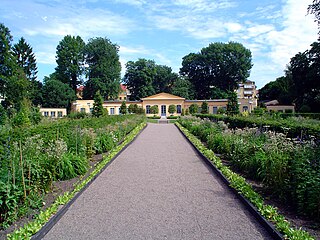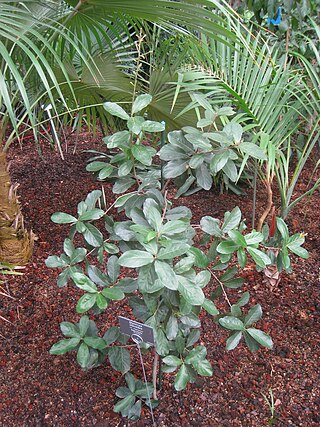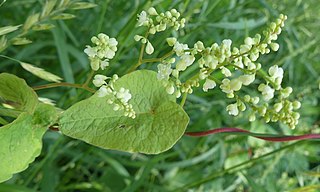In biology, a tribe is a taxonomic rank above genus, but below family and subfamily. It is sometimes subdivided into subtribes. By convention, all taxonomic ranks from genus upwards are capitalized, including both tribe and subtribe.

The International Code of Nomenclature for algae, fungi, and plants is the set of rules and recommendations dealing with the formal botanical names that are given to plants, fungi and a few other groups of organisms, all those "traditionally treated as algae, fungi, or plants". It was formerly called the International Code of Botanical Nomenclature (ICBN); the name was changed at the International Botanical Congress in Melbourne in July 2011 as part of the Melbourne Code which replaced the Vienna Code of 2005.
In the scientific name of organisms, basionym or basyonym means the original name on which a new name is based; the author citation of the new name should include the authors of the basionym in parentheses. The term "basionym" is used in both botany and zoology. In zoology, alternate terms such as original combination or protonym are sometimes used instead. Bacteriology uses a similar term, basonym, spelled without an i.

The International Association for Plant Taxonomy (IAPT) is an organization established to promote an understanding of plant biodiversity, facilitate international communication of research between botanists, and oversee matters of uniformity and stability in plant names. The IAPT was founded on July 18, 1950, at the Seventh International Botanical Congress in Stockholm, Sweden. The IAPT headquarters is located in Bratislava, Slovakia. Its president, since 2017, is Patrick S. Herendeen of the Chicago Botanic Garden; vice-president is Gonzalo Nieto Feliner of the Real Jardín Botánico, Madrid; and secretary-general is Karol Marhold of the Plant Science and Biodiversity Centre, Slovak Academy of Sciences, Bratislava.
Botanical nomenclature is the formal, scientific naming of plants. It is related to, but distinct from taxonomy. Plant taxonomy is concerned with grouping and classifying plants; botanical nomenclature then provides names for the results of this process. The starting point for modern botanical nomenclature is Linnaeus' Species Plantarum of 1753. Botanical nomenclature is governed by the International Code of Nomenclature for algae, fungi, and plants (ICN), which replaces the International Code of Botanical Nomenclature (ICBN). Fossil plants are also covered by the code of nomenclature.
Nomenclature codes or codes of nomenclature are the various rulebooks that govern biological taxonomic nomenclature, each in their own broad field of organisms. To an end-user who only deals with names of species, with some awareness that species are assignable to families, it may not be noticeable that there is more than one code, but beyond this basic level these are rather different in the way they work.
In botany, the correct name according to the International Code of Nomenclature for algae, fungi, and plants (ICN) is the one and only botanical name that is to be used for a particular taxon, when that taxon has a particular circumscription, position and rank. Determining whether a name is correct is a complex procedure. The name must be validly published, a process which is defined in no less than 16 Articles of the ICN. It must also be "legitimate", which imposes some further requirements. If there are two or more legitimate names for the same taxon, then the correct name is the one which has priority, i.e. it was published earliest, although names may be conserved if they have been very widely used. Validly published names other than the correct name are called synonyms. Since taxonomists may disagree as to the circumscription, position or rank of a taxon, there can be more than one correct name for a particular plant. These may also be called synonyms.
A conserved name or nomen conservandum is a scientific name that has specific nomenclatural protection. That is, the name is retained, even though it violates one or more rules which would otherwise prevent it from being legitimate. Nomen conservandum is a Latin term, meaning "a name to be conserved". The terms are often used interchangeably, such as by the International Code of Nomenclature for Algae, Fungi, and Plants (ICN), while the International Code of Zoological Nomenclature favours the term "conserved name".

Coleus barbatus, also known by the synonyms Plectranthus barbatus and incorrectly Coleus forskalaei, is a tropical perennial plant related to the typical coleus species. It produces forskolin, an extract useful for pharmaceutical preparations and research in cell biology.
Aralia castanopsicola, synonym Pentapanax castanopsicola, is a species of plant in the family Araliaceae. It is endemic to Taiwan. It is threatened by habitat loss. The specific epithet is spelt in various ways, including castanopsidicola.
Galium hardhamiae is a species of flowering plant in the coffee family Rubiaceae, known by the common name Hardham's bedstraw. The scientific name may be misspelled Galium hardhamae. It is endemic to the Santa Lucia Range of southern Monterey County and northern San Luis Obispo County in California. It is a member of the serpentine soils flora in these coastal mountains. This is a perennial herb forming mats or clumps of stems no more than 30 centimeters long. The stems have many whorls of six fleshy green leaves, each leaf just 1 to 3 millimeters long. The inflorescences, clusters of yellow-green to pinkish flowers, appear in leaf axils.

Vriesea wawrana is a plant species in the genus Vriesea. This species is endemic to Brazil.

Quercus sagrana, also spelt Quercus sagraeana, the Cuban oak, is a medium-sized evergreen tree native to western Cuba in the Cuban pine forests ecoregion. It is the only oak native to the Caribbean.

Disanthus cercidifolius is a species of flowering plant in the family Hamamelidaceae. It is native to woodland habitats in China and Japan.

Cranfillia fullagari, synonym Blechnum fullagarii, is a fern in the family Blechnaceae. The specific epithet honours James Fullagar, who collected plants on Lord Howe Island for the Royal Botanic Gardens, Melbourne.
Quercus margarettae, the sand post oak or dwarf post oak, is a North American species of oak in the beech family. It is native to the southeastern and south-central United States from Virginia to Florida and west as far as Texas and Oklahoma. There are historical reports of the species growing in New York State, but it has not been seen there in years.

Acis ionica is a species of flowering plant in the family Amaryllidaceae, native from south-western Albania to western Greece. It was initially confused with what is now Acis valentina, a species found in Spain near Valencia.
Ponerorchis tominagae is a species of flowering plant in the family Orchidaceae, native to Taiwan.

Polygonum ciliinode is a species of flowering plant in the family Polygonaceae, native to central and eastern Canada, and the north-central and eastern United States. The specific epithet is also spelt cilinode.

Taxon is a bimonthly peer-reviewed scientific journal covering plant taxonomy. It is published by Wiley on behalf of the International Association for Plant Taxonomy, of which it is the official journal. It was established in 1952 and is the only place where nomenclature proposals and motions to amend the International Code of Nomenclature for algae, fungi, and plants can be published. The editor-in-chief is Dirk C. Albach.









